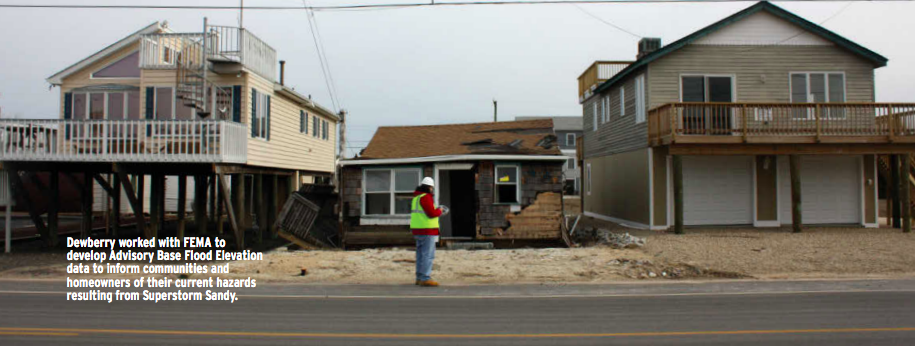AMERICAN COUNCIL OF ENGINEERING COMPANIES (ACEC)
Engineering firms are developing disaster mitigation strategies that better prepare a world faced with ever-increasing natural calamities before they occur.
 As weather-related events such as hurricanes multiply and intensify, states and municipalities are recognizing the urgent need to fund mitigation strategies. Because the occurrence and intensity of calamitous events have increased dramatically in recent years— largely due to climate change-related weather patterns and rising sea levels as well as increasing development in vulnerable areas—rebuilding and then waiting for the next disaster to strike, over and over again, is no longer a sustainable strategy.
As weather-related events such as hurricanes multiply and intensify, states and municipalities are recognizing the urgent need to fund mitigation strategies. Because the occurrence and intensity of calamitous events have increased dramatically in recent years— largely due to climate change-related weather patterns and rising sea levels as well as increasing development in vulnerable areas—rebuilding and then waiting for the next disaster to strike, over and over again, is no longer a sustainable strategy.
As a result, more engineering firms—which play a critical role in the aftermath of catastrophes, helping restore dams, levees and other flood-protection systems; getting transportation systems back up and running; reconstructing residential and commercial buildings; and mending other types of broken infrastructure—are increasingly looking at disaster mitigation strategies that can reduce or even prevent the devastation.
“We are engineers and architects, but you have to morph, adjust and adapt to the marketplace,” says Ted Van Kirk, executive vice president of Dewberry.
Despite the shifting mindset on addressing mitigation of risks from major disasters, the federal government remains largely focused on post-disaster cleanup. That fact is reflected in the funding levels for disaster response efforts, which have not kept pace with the increase in frequency and intensity of these events and, in some cases, has even been reduced. Of the $277.6 billion the government obligated on disaster assistance from 2005 to 2014, very little went to reducing communities’ risks before hurricanes and floods hit.
Pre-disaster mitigation spending by the Federal Emergency Management Agency (FEMA) fell to $19 million in 2014 from $157 million in 2005. And funding is not the only hurdle to overcome. Various federal rules favor rebuilding rather than resilience. For example, the Robert T. Stafford Disaster Relief and Emergency Assistance Act, which was signed into law in 1988 and amended in 2016, requires money be used to replace exactly what was there before a storm.
THE CASE FOR FUTURE RISK MITIGATION
With the rates of incidence, and associated cleanup costs, on the rise, more and more experts agree that the better solution is to develop plans and complete projects beforehand—in the vein of practicing preventive medicine today to avoid illnesses tomorrow.
“You can do mitigation and resiliency projects as part of disaster recovery, and certainly need to when rebuilding,” says Van Kirk. However, creating a strategy that allows communities to access funds for proactive resiliency gives those communities an opportunity to pre-emptively assess their vulnerabilities and prioritize projects to address them, he says.
There is already evidence that this sort of planning pays off.
For every $1 spent on pre-event mitigation, both before and after disasters, U.S. taxpayers save an average of $4 in future disaster recovery costs, according to The National Institute of Building Sciences (NIBS) findings in its “Natural Hazard Mitigation Saves: 2017 Interim Report.” Not only does it cost less, barriers made up of levees, floodwalls and pump stations, as well as numerous gates to close streets and railroads that pass through the lines of protection. In July, the Corps of Engineers approved $117 million in funding, and the state of Iowa will contribute $267 million. The city has pledged $110 million for the project, on top of the $10 million it has already invested.
“It is a good time to be in this business,” says Van Kirk. “The critical issue is finding qualified people who understand disasters. There are not enough people out there for all the firms who want them.”
The urgency to mitigate future risks of flooding has increased alongside growing evidence that climate change is intensifying weather-related events. Those unprecedented weather events, such as Hurricane Harvey, which dumped 4-plus feet of rain in and around Houston last year, mean astronomical financial costs for relief, recovery and rebuilding operations. Case in point, 2017 was the most expensive year ever in the U.S. for weather and climate-related disasters, totaling $306 billion, according to the National Oceanic and Atmospheric Administration (NOAA). And the cleanup efforts in Puerto Rico after Hurricane Maria, one of three Category 4 hurricanes that made landfall in the U.S. and its territories, are estimated at $139 billion—15 times that of the island’s $9 million annual budget. The first quarter of 2018 saw three nor’easters, followed by historic wildfires that ravaged California. All that before Hurricane Florence hit the East Coast in September.
The costs are not limited to weather events. Climate change is also causing rising sea levels, including a new phenomenon known as “sunny day” flooding in coastal cities, especially along the East Coast, on days when it is not even raining.
A University of Florida study published in 2017 found that from 2011 to 2015, sea level rose up to 5 inches—an inch per year—in some locales from North Carolina to Florida. That includes Virginia Beach, Virginia, where sea levels in the Hampton Roads region—home to the world’s largest naval base—have risen nearly 12 inches since 1960, according to NOAA. The result is frequent flooding of low-lying coastal areas and a storm water system often unable to drain the overflow. A study by the Hampton Roads Planning District Commission estimated that the region could face direct economic costs of $12 billion to $87 billion due to rising seas by the end of the century.
Download full article (PDF): Planning Today for Tomorrow’s Disasters
Download full November/December issue of Engineering, Inc.
 About the American Council of Engineering Companies
About the American Council of Engineering Companies
www.acec.org
The American Council of Engineering Companies (ACEC) is the voice of America’s engineering industry. Council members – numbering more than 5,000 firms representing more than 500,000 employees throughout the country – are engaged in a wide range of engineering works that propel the nation’s economy, and enhance and safeguard America’s quality of life. These works allow Americans to drink clean water, enjoy a healthy life, take advantage of new technologies, and travel safely and efficiently. The Council’s mission is to contribute to America’s prosperity and welfare by advancing the business interests of member firms.
Tags: ACEC, American Council of Engineering Companies, disaster mitigation, Engineering Inc., Hurricanes, risk mitigation, Weather







 RSS Feed
RSS Feed